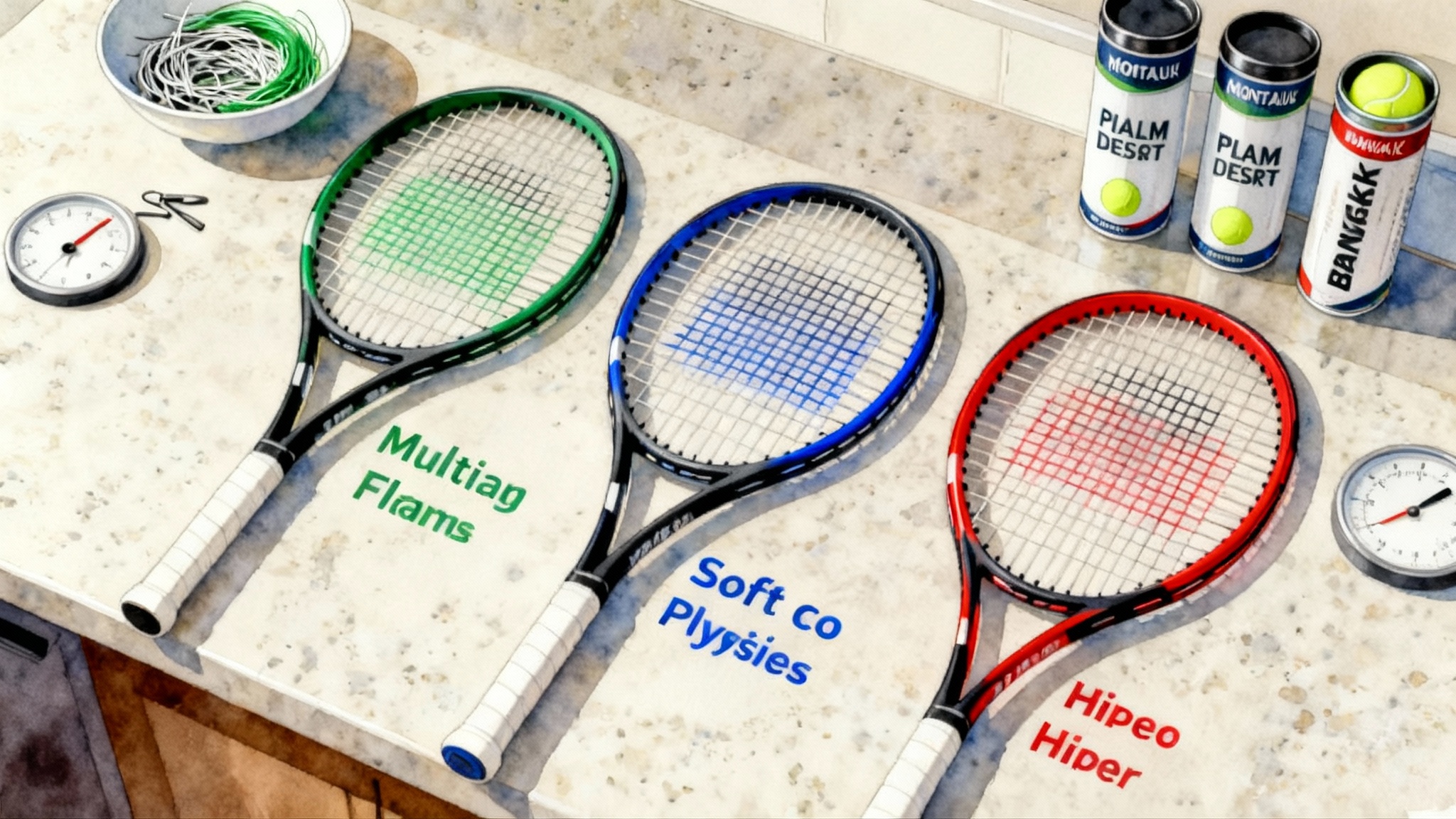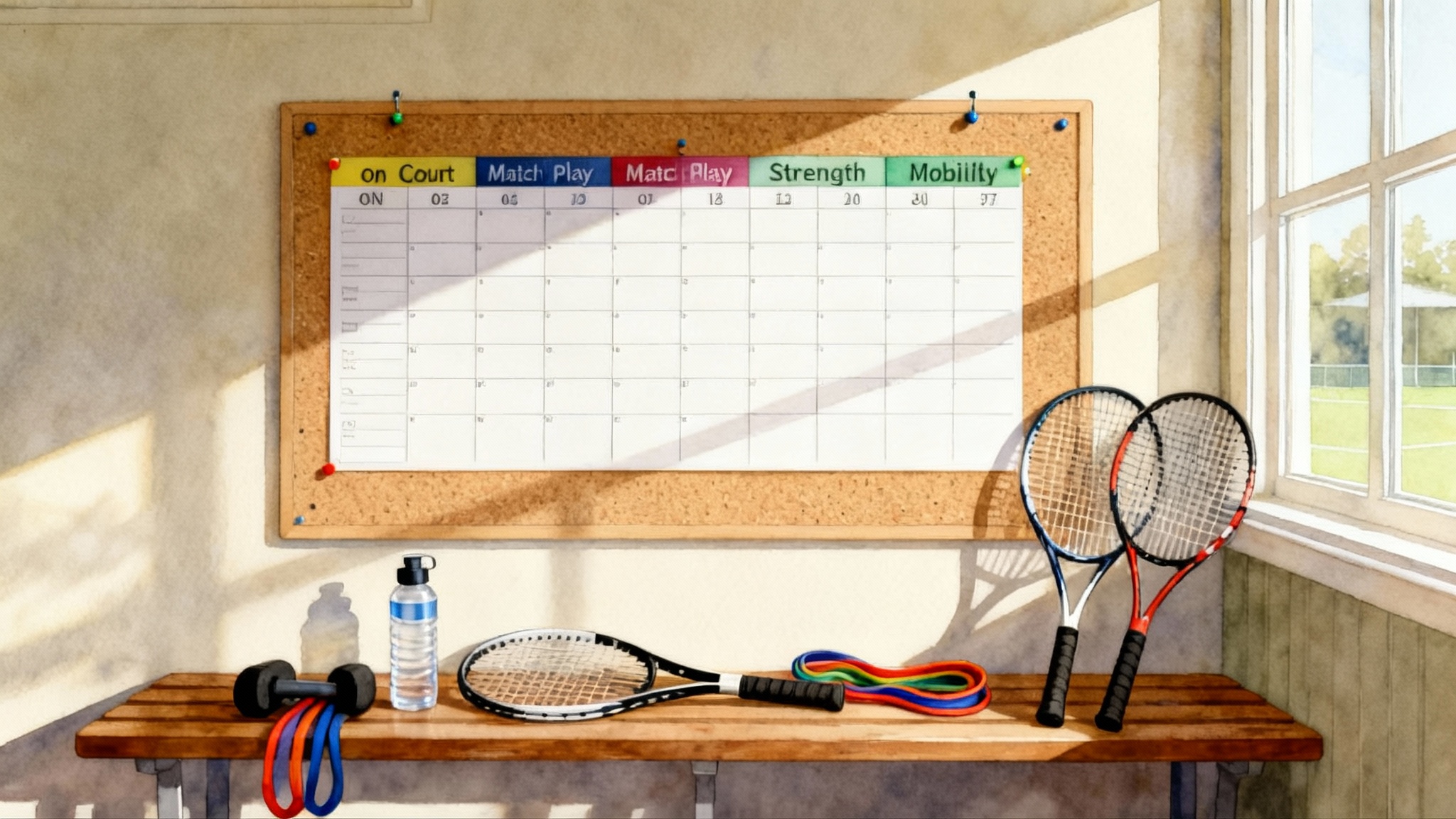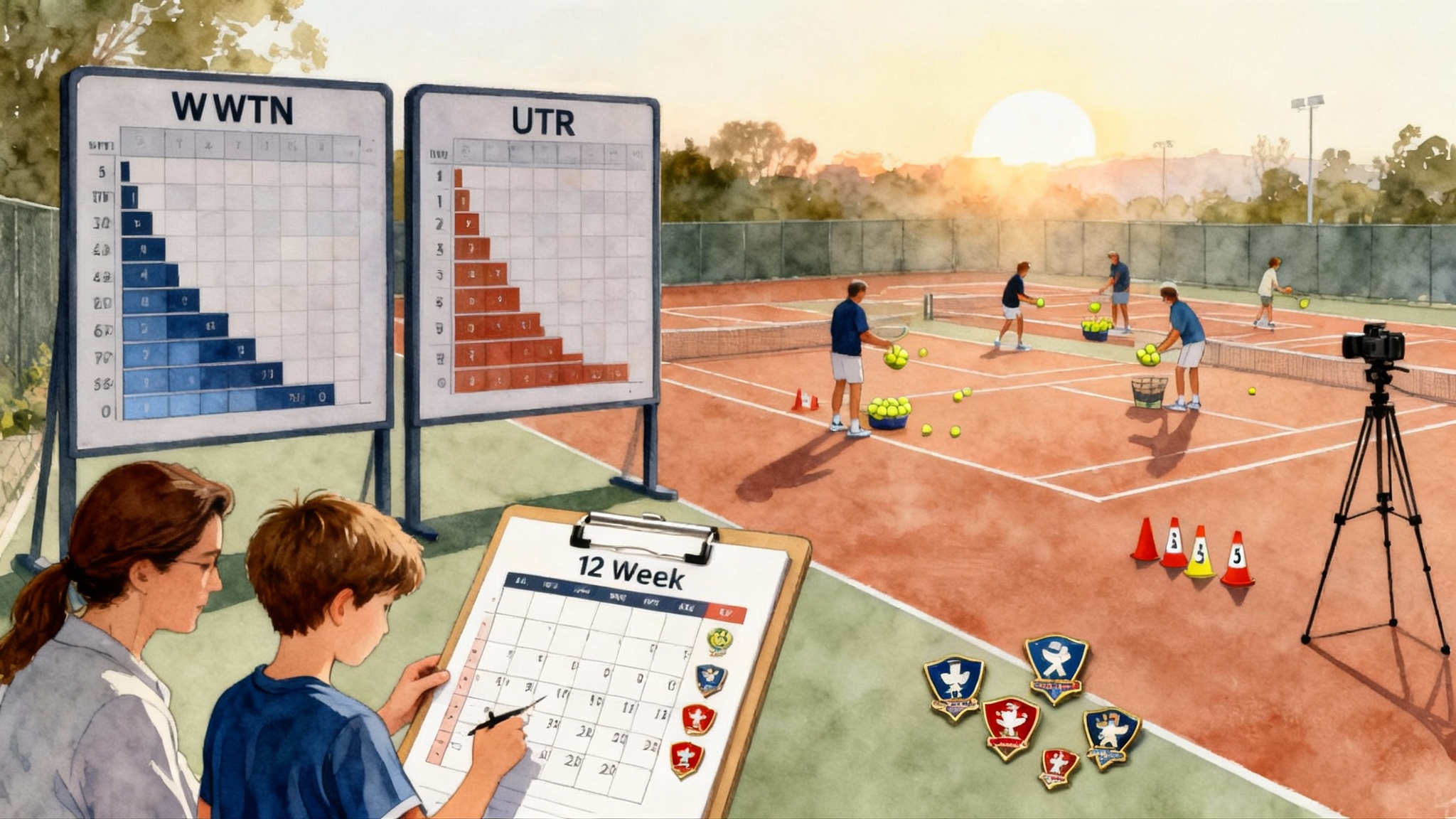Tennis Strings and Tension 2025: Safe Setups for Juniors, Adults
A practical, evidence-informed guide to modern string choices and starter tension bands by racquet size and swing speed. Includes climate tweaks for Montauk, Palm Desert, and Bangkok, plus easy safety rules and three plug and play builds.

Why strings and tension matter in 2025
Strings are the engine of your racquet. They decide how the ball launches, how much spin you can produce, how much shock reaches your arm, and how long your setup stays playable. Two players can swing the same racquet and get very different results because of string type, gauge, and tension. The goal of this guide is simple. Give you safe, effective starting points that you can actually use at your next restring, then show you how to adjust based on your swing, court surface, and climate.
This guide focuses on four string families you can find at most pro shops.
- Synthetic gut: a single solid nylon core with wraps. Affordable, lively, and arm friendly. Brands include Prince Synthetic Gut with Duraflex and Wilson Synthetic Gut Power.
- Multifilament: hundreds or thousands of nylon microfibers bonded together. Very comfortable, powerful, and good for arms that need relief. Examples include Tecnifibre X One Biphase, Babolat Xcel, and Wilson NXT.
- Soft co polyester: a newer breed of polyester blends designed to be less harsh than traditional poly strings. Think Luxilon Element, Solinco Hyper G Soft, Babolat RPM Soft, and Yonex Poly Tour Pro. These offer spin and control at lower tensions but still go dead faster than nylon.
- Hybrids: mixing two strings in the same racquet, one in the mains and one in the crosses. Common mixes include poly mains with a multifilament or synthetic gut cross for comfort, or the reverse for more power and feel.
Key ideas to remember as you read.
- Lower tension increases pocketing and power, and often improves comfort.
- Higher tension reduces launch angle and power, which can add control for fast swings but may feel harsher.
- Polyester loses playability faster than nylon. If you use any polyester, plan to restring more often.
- Juniors and anyone with arm symptoms should favor nylon based builds or very soft hybrid mixes at sensible tensions.
Starter tension bands by racquet head size and swing speed
Use this table to set a safe starting tension. Pick your swing description and head size, then choose the column that matches your build. Ranges are in pounds, strung on a modern 16 by 19 or 18 by 20 pattern. If your pattern is unusually open or closed, adjust one to two pounds as needed.
| Head size and swing | Multi or Synthetic Gut | Soft Co Polyester or Hybrid |
|---|---|---|
| 95 to 100 sq in, compact or smooth swing | 55 to 58 | 47 to 50 |
| 95 to 100 sq in, average swing | 53 to 56 | 45 to 48 |
| 95 to 100 sq in, long and fast swing | 51 to 54 | 43 to 46 |
| 100 to 102 sq in, compact or smooth swing | 54 to 57 | 46 to 49 |
| 100 to 102 sq in, average swing | 52 to 55 | 44 to 47 |
| 100 to 102 sq in, long and fast swing | 50 to 53 | 42 to 45 |
| 103 to 110 sq in, compact or smooth swing | 56 to 59 | 48 to 51 |
| 103 to 110 sq in, average swing | 54 to 57 | 46 to 49 |
| 103 to 110 sq in, long and fast swing | 52 to 55 | 44 to 47 |
Notes and safety modifiers.
- Under 14 or recovering from elbow or shoulder pain: avoid a full bed of polyester. Choose multifilament or synthetic gut, or use a hybrid with nylon mains and a soft poly cross. Subtract two pounds from the nylon ranges if you want extra comfort.
- If you are a frequent string breaker who still needs comfort, move to a thicker gauge before you raise tension. Thicker nylon or a hybrid with nylon mains will usually protect your arm better than a big jump in tension.
- If you are switching between string families, do not copy tension numbers. Start within the bands above for that family and make small changes after two or three sessions.
Three plug and play builds
Below are three simple builds that cover most needs. Each includes a default gauge, tension by head size, and why it works. You can swap brands within the same family if your shop carries different inventory.
Spin build
For players who hit up on the ball and want more RPMs without a harsh feel.
- Composition: full bed of soft co polyester or a hybrid with soft poly mains and nylon crosses.
- Gauge: 17L or 18 in poly for better snapback, 16 or 16L in nylon cross for a stable bed.
- Tension by head size:
- 95 to 100: 44 to 47 for a full soft poly, or 46 to 49 with poly mains and nylon crosses.
- 100 to 102: 43 to 46 for full soft poly, or 45 to 48 in a poly main hybrid.
- 103 to 110: 46 to 49 for full soft poly, or 48 to 51 in a poly main hybrid.
- Examples: Solinco Hyper G Soft, Babolat RPM Soft, Yonex Poly Tour Pro for mains, paired with Prince Synthetic Gut or Wilson NXT crosses if you hybrid.
- Why it works: a thin, slick poly main helps the mains slide and snap back, which raises spin. The lower tension keeps the stringbed from feeling boardy and protects your arm.
Control build
For strong adults with long, fast swings who want a predictable launch and directional accuracy.
- Composition: full bed of soft to middle firm co polyester, or a hybrid with poly crosses under a nylon main if you like a crisper pocket.
- Gauge: 16L or 17 in co polyester, 16 in nylon.
- Tension by head size:
- 95 to 100: 46 to 49 for full poly, or 50 to 53 with nylon mains and poly crosses.
- 100 to 102: 45 to 48 for full poly, or 49 to 52 with nylon mains and poly crosses.
- 103 to 110: 48 to 51 for full poly, or 51 to 54 with nylon mains and poly crosses.
- Examples: Luxilon Element, Head Lynx Touch, Solinco Confidential Soft blended with a durable nylon like Prince Synthetic Gut if you hybrid.
- Why it works: a slightly higher reference tension narrows your launch window and keeps flatter drives on a line. The soft class of poly maintains feel without punishing your arm.
Arm friendly build
For juniors, developing adults, and anyone who feels soreness after play.
- Composition: full multifilament or a robust synthetic gut. If you want a touch more bite, try nylon mains with a soft poly cross at a low tension.
- Gauge: 16 or 16L for durability, 17 if you want more feel and do not break often.
- Tension by head size:
- 95 to 100: 53 to 57 for full multi or synthetic gut, or 50 to 53 for nylon mains with a soft poly cross.
- 100 to 102: 52 to 56 for full multi or synthetic gut, or 49 to 52 for nylon mains with a soft poly cross.
- 103 to 110: 54 to 58 for full multi or synthetic gut, or 51 to 54 for nylon mains with a soft poly cross.
- Examples: Tecnifibre X One Biphase, Babolat Xcel, Wilson NXT, Prince Synthetic Gut with Duraflex.
- Why it works: nylon based beds absorb impact and return more energy to the ball, so you do not have to swing as hard to reach depth. This protects the elbow and shoulder while you build skill.
Surface and climate adjustments at three academies
Real courts in real weather change how your stringbed plays. Use these location based tweaks as a quick reference.
Har Tru in Montauk, New York
If you train at Gotham Tennis Academy, note that Har Tru plays lower and slower than many hard courts. Moisture in the air and heavier balls reduce rebound speed. Players often complain that the ball sits up rather than skidding through.
- How to adjust:
- If you use nylon based setups, drop one to two pounds to add depth without overswinging.
- If you use soft poly or a poly hybrid, stay within your range but bias one pound lower for extra pocketing and bite.
- Consider a thinner gauge for the clay season. A 17 or 17L will help the mains slide and find a bit more spin.
- Pro move: clean your strings mid session. Clay dust reduces snapback. A quick wipe with a dry towel between games keeps performance stable.
Dry heat in Palm Desert, California
If you play in the Coachella Valley, Desert Tennis Academy at Shadow Mountain Resort sits in very dry heat that makes the ball bounce lively. Stringbeds also soften during long hot sessions, so your launch angle can creep up late in the day.
- How to adjust:
- If you are sailing balls long in the afternoon, raise reference tension two to three pounds within your safe range.
- Favor a slightly firmer or thicker option in your family. For example move from a 17 to a 16L soft poly, or from a very soft multifilament to a more controlled one.
- Keep a dampener in your bag if you normally use one. Hot balls off firm strings can feel and sound loud. Reducing chatter reduces the urge to overtighten next time.
- Pro move: mark a midday and late day line on your setup card. If you often play at 3 p.m., string for the 3 p.m. feel, not the cool morning feel.
Humid indoor courts in Bangkok, Thailand
If you are in Bangkok, APF Academies runs indoor sessions in humidity that makes balls heavier and slows conditions. Feel can be muted, and off center contact can feel sticky rather than crisp.
- How to adjust:
- Drop one to two pounds for extra depth, especially with full nylon beds.
- If you want more spin without harshness, try a hybrid with soft poly mains and nylon crosses rather than jumping straight to a full poly bed.
- Wipe strings between changeovers. Humidity plus felt fibers reduces slickness and hurts snapback.
- Pro move: ask the stringer to add a light pre stretch to multifilament if you are sensitive to tension loss. This can keep the bed from feeling mushy after the first hour.
Restringing intervals made simple
You do not need a device to manage playability. Use these rules, then adjust based on how you hit and how often you play.
- The simple annual rule: restring as many times per year as you play per week. If you play three times a week, plan on at least three restrings per year for nylon based setups.
- The hours rule for polyester: any setup with poly should be refreshed every 10 to 20 hours of play. Big hitters who hit heavy spin live at the low end of that range.
- The hours rule for nylon: multifilament or synthetic gut plays well for 20 to 30 hours, sometimes longer if you are not a breaker. Fraying is normal, but when half the string length is frayed or the bed feels dull and launches low, it is time.
- The performance rule: if you add two to three pounds at your next string job to chase control and you still launch balls, your strings are dead. Fresh strings will restore control better than another tension increase.
Write your play hours on a small tag in your bag. You will pick up patterns within a month.
Arm safety checkpoints and when to cut out poly
Arm health comes first. Use this short checklist to stay safe.
- The 48 hour check: after your first two sessions on a new setup, assess soreness the next morning. If your elbow or shoulder feels stiffer than usual or you feel a deep ache when turning a doorknob, cut the strings out or move down two pounds next time.
- The mis hit tolerance test: if frame tip contact stings your hand through the handle, your bed is either too tight or too stiff for you. Lower tension or switch to nylon based strings.
- The sound test: a dull, thuddy sound after two weeks on poly often means the stringbed has lost life. Do not keep grinding on a dead bed.
- The spin test: if your poly setup stops snapping back and the strings stay out of place between points, you have lost lubrication and elasticity. Time to restring.
When to cut out polyester immediately.
- Any sharp or escalating elbow pain during play.
- Any tingling or numbness in the forearm or fingers after play.
- A tension jump because of a bad stringing mistake, for example strung ten pounds higher than requested. Start fresh rather than trying to play through.
Safer ways to keep the feel you like from poly.
- Hybrid with nylon mains at a slightly higher tension. You will keep some spin while reducing impact shock.
- Use a softer class of poly, often labeled as soft or comfort in the product line.
- Drop gauge to 17L or 18 to help the mains move without raising reference tension.
A three question path to your best setup
Use this flow, then bring your answers to a stringing consult. It takes two minutes.
- Do you have a recent elbow or shoulder issue, or are you under 14 years old?
- Yes: choose the arm friendly build. Full multifilament or synthetic gut. If you need spin, try nylon mains with a soft poly cross at a low tension. Start inside the higher half of the nylon ranges for better directional control.
- No: go to question two.
- How would you describe your swing speed on groundstrokes?
- Compact or smooth: start with the mid to high end of your range for nylon, or the high end of the soft poly range if you need spin. You will gain control without harshness.
- Average: choose the middle of the bands for your head size. Adjust one pound at a time after two sessions.
- Long and fast: start low in your range for soft poly or on the low side for nylon. You create your own power, so you want pocketing without a rocket launcher.
- How often do you play and break strings?
- Two or fewer times per week and you rarely break: nylon based setups will be cost effective and kind to your arm. Plan each restring by season.
- Three or more times per week or you break often: use the spin or control build and follow the 10 to 20 hour poly rule. Keep a stringing log with dates and hours.
Next step: book a stringing and fit consult. If you play on Har Tru in Montauk, visit the front desk at Gotham Tennis Academy and reference this guide to start with the clay tweaks above. If you live or travel in the Coachella Valley, ask Desert Tennis Academy to implement the Palm Desert adjustments. If you train in Bangkok, APF Academies can apply the indoor humidity tweaks and help you test a soft hybrid versus full nylon.
Quick tuning tips you can feel on court
- Add two pounds if your balls are flying long with the center of the stringbed and your timing feels fine. Remove two pounds if you are leaving sitters short even when you contact cleanly.
- Move your strings back into place between points. If they slide freely and snap back, you are in a healthy window for spin. If they stay out of place, restring or switch to a slicker string family.
- Try a 17 or 17L gauge if you cannot feel the ball at contact. Try a 16 or 16L if you spray when you take a full swing.
- String savers can extend life on multifilament and synthetic gut for chronic string breakers, but they raise stringbed stiffness a touch. Add them near the sweet spot, not across the whole bed.
Putting it all together
Pick a build that matches your current body and swing, not the one you hope to grow into. Start with the safe bands, play two sessions, then make one change at a time. Use the academy based climate notes to fine tune for your courts. Keep a simple log of hours and string type so you can spot when performance drops. When in doubt, protect your arm and go nylon or a soft hybrid for a month while you rebuild timing. The right stringbed makes good swings feel easier, protects your body, and turns match day into a simple choice rather than a guessing game.







